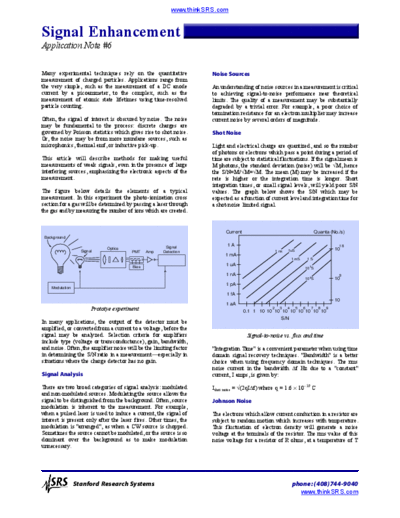Service Manuals, User Guides, Schematic Diagrams or docs for : Stanford Research Systems www.thinksrs.com-SignalEnhancement
<< Back | HomeMost service manuals and schematics are PDF files, so You will need Adobre Acrobat Reader to view : Acrobat Download Some of the files are DjVu format. Readers and resources available here : DjVu Resources
For the compressed files, most common are zip and rar. Please, extract files with Your favorite compression software ( WinZip, WinRAR ... ) before viewing. If a document has multiple parts, You should download all, before extracting.
Good luck. Repair on Your own risk. Make sure You know what You are doing.
Image preview - the first page of the document

>> Download www.thinksrs.com-SignalEnhancement documenatation <<
Text preview - extract from the document
www.thinkSRS.com
Signal Enhancement
Application Note #6
Many experimental techniques rely on the quantitative Noise Sources
measurement of charged particles. Applications range from
the very simple, such as the measurement of a DC anode An understanding of noise sources in a measurement is critical
current by a picoammeter, to the complex, such as the to achieving signal-to-noise performance near theoretical
measurement of atomic state lifetimes using time-resolved limits. The quality of a measurement may be substantially
particle counting. degraded by a trivial error. For example, a poor choice of
termination resistance for an electron multiplier may increase
Often, the signal of interest is obscured by noise. The noise current noise by several orders of magnitude.
may be fundamental to the process: discrete charges are
governed by Poisson statistics which gives rise to shot noise. Shot Noise
Or, the noise may be from more mundane sources, such as
microphonics, thermal emf, or inductive pick-up. Light and electrical charge are quantized, and so the number
of photons or electrons which pass a point during a period of
This article will describe methods for making useful time are subject to statistical fluctuations. If the signal mean is
measurements of weak signals, even in the presence of large M photons, the standard deviation (noise) will be M, hence
interfering sources, emphasizing the electronic aspects of the the S/N=M/M=M. The mean (M) may be increased if the
measurement. rate is higher or the integration time is longer. Short
integration times, or small signal levels, will yield poor S/N
The figure below details the elements of a typical values. The graph below shows the S/N which may be
measurement. In this experiment the photo-ionization cross expected as a function of current level and integration time for
section for a gas will be determined by passing a laser through a shot-noise limited signal.
the gas and by measuring the number of ions which are created.
Current Quanta (No./s)
Background
Signal 1A 18
Optics 1uS 10
Signal PMT Amp Detection 1 ns
1 mA
1 mS 1S
Bias
1 uA
10 3 S
1 nA 9
10 6 S 10
1 pA
Modulation
1 fA
10
1 aA
Prototye experiment 2 3 4 5
0.1 1 10 10 10 10 10 10 10 10 10
6 7 8 9
S/N
In many applications, the output of the detector must be
amplified, or converted from a current to a voltage, before the
signal may be analyzed. Selection criteria for amplifiers Signal-to-noise vs. flux and time
include type (voltage or transconductance), gain, bandwidth,
and noise. Often, the amplifier noise will be the limiting factor "Integration Time" is a convenient parameter when using time
in determining the S/N ratio in a measurementespecially in domain signal recovery techniques. "Bandwidth" is a better
situations where the charge detector has no gain. choice when using frequency domain techniques. The rms
noise current in the bandwidth f Hz due to a "constant"
Signal Analysis current, I amps, is given by:
There are two broad categories of signal analysis: modulated Ishot noise = (2qIf) where q = 1.6 ◦ Jabse Service Manual Search 2024 ◦ Jabse Pravopis ◦ onTap.bg ◦ Other service manual resources online : Fixya ◦ eServiceinfo